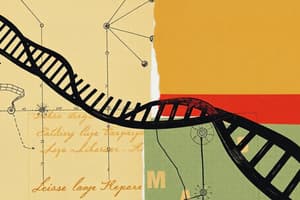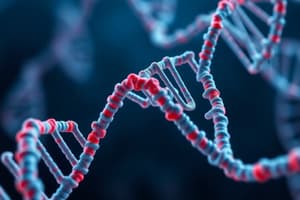Podcast
Questions and Answers
What is the primary role of DNA primase in DNA synthesis?
What is the primary role of DNA primase in DNA synthesis?
- To stabilize the DNA double helix during synthesis
- To add RNA primers to initiate DNA polymerization (correct)
- To generate energy for the polymerization process
- To remove errors introduced during DNA synthesis
Why can't DNA polymerase start polymerizing DNA directly?
Why can't DNA polymerase start polymerizing DNA directly?
- It requires a DNA template strand first
- It requires multiple RNA primers initially
- It needs a free 3'OH group added by primase (correct)
- It cannot recognize incoming nucleotides
What is the primary function of DNA polymerase I?
What is the primary function of DNA polymerase I?
- Elongates the leading strand
- Substitutes for DNA polymerase II
- Synthesizes RNA primers
- Fills in small DNA segments during repair or replication (correct)
What happens to RNA primers after DNA synthesis is complete?
What happens to RNA primers after DNA synthesis is complete?
Which DNA polymerase is responsible for synthesizing the lagging strand in eukaryotes?
Which DNA polymerase is responsible for synthesizing the lagging strand in eukaryotes?
What is one limitation of DNA primase during DNA synthesis?
What is one limitation of DNA primase during DNA synthesis?
How does DNA polymerase ensure correct base pairing during DNA synthesis?
How does DNA polymerase ensure correct base pairing during DNA synthesis?
What role does the sliding clamp protein play in DNA replication?
What role does the sliding clamp protein play in DNA replication?
How does DNA polymerase correct errors made during DNA replication?
How does DNA polymerase correct errors made during DNA replication?
Which statement about prokaryotic DNA replication is accurate?
Which statement about prokaryotic DNA replication is accurate?
What forms the backbone of a DNA strand?
What forms the backbone of a DNA strand?
Which enzyme is responsible for synthesizing RNA primers during DNA replication?
Which enzyme is responsible for synthesizing RNA primers during DNA replication?
What is the function of topoisomerase in DNA replication?
What is the function of topoisomerase in DNA replication?
Why is DNA replication considered semiconservative?
Why is DNA replication considered semiconservative?
What is unique about the lagging strand during DNA replication?
What is unique about the lagging strand during DNA replication?
What type of exonuclease activity does DNA Pol III possess?
What type of exonuclease activity does DNA Pol III possess?
What error rate does DNA replication achieve due to proofreading mechanisms?
What error rate does DNA replication achieve due to proofreading mechanisms?
What occurs immediately after an incorrect nucleotide is incorporated during DNA replication?
What occurs immediately after an incorrect nucleotide is incorporated during DNA replication?
Which of the following statements is true regarding strand-directed mismatch repair?
Which of the following statements is true regarding strand-directed mismatch repair?
What is the role of the 3’ to 5’ proofreading exonuclease in DNA Pol?
What is the role of the 3’ to 5’ proofreading exonuclease in DNA Pol?
Flashcards
DNA Replication
DNA Replication
The process by which a DNA molecule is duplicated, creating two identical copies.
Antiparallel Strands
Antiparallel Strands
The two strands of DNA run in opposite directions, with one strand going from 5' to 3' and the other going from 3' to 5'.
Chargaff's Rule
Chargaff's Rule
The rule that states that in DNA, adenine (A) always pairs with thymine (T), and cytosine (C) always pairs with guanine (G).
Semiconservative Replication
Semiconservative Replication
Signup and view all the flashcards
Semidiscontinuous Replication
Semidiscontinuous Replication
Signup and view all the flashcards
3' to 5' exonuclease activity
3' to 5' exonuclease activity
Signup and view all the flashcards
5' to 3' exonuclease activity
5' to 3' exonuclease activity
Signup and view all the flashcards
Proofreading
Proofreading
Signup and view all the flashcards
Strand-directed mismatch repair
Strand-directed mismatch repair
Signup and view all the flashcards
Nick
Nick
Signup and view all the flashcards
What is the role of DNA polymerase I (Pol I)?
What is the role of DNA polymerase I (Pol I)?
Signup and view all the flashcards
What is the key role of DNA polymerase III (Pol III)?
What is the key role of DNA polymerase III (Pol III)?
Signup and view all the flashcards
What does the DNA polymerase α/primase complex do?
What does the DNA polymerase α/primase complex do?
Signup and view all the flashcards
What is the function of a sliding clamp protein?
What is the function of a sliding clamp protein?
Signup and view all the flashcards
What does DNA ligase do?
What does DNA ligase do?
Signup and view all the flashcards
What role does DNA primase play in DNA replication?
What role does DNA primase play in DNA replication?
Signup and view all the flashcards
Why does DNA polymerase need to replace RNA primers?
Why does DNA polymerase need to replace RNA primers?
Signup and view all the flashcards
Why is DNA primase less accurate than DNA polymerase?
Why is DNA primase less accurate than DNA polymerase?
Signup and view all the flashcards
How does DNA polymerase build a new strand of DNA?
How does DNA polymerase build a new strand of DNA?
Signup and view all the flashcards
What is the role of exonuclease activity in DNA polymerase?
What is the role of exonuclease activity in DNA polymerase?
Signup and view all the flashcards
Study Notes
DNA Replication
- DNA replication is a semi-conservative process, producing two identical DNA molecules from one original DNA molecule.
- Each new DNA molecule consists of one original strand and one new strand.
- The process begins with the unwinding of the DNA double helix, creating a replication fork.
- DNA helicases are responsible for disrupting hydrogen bonds to separate DNA strands.
- Topoisomerases remove topological links between the two strands, facilitating unwinding.
- DNA primase synthesizes short RNA primers to initiate DNA replication.
- DNA polymerase synthesizes new DNA strands complementary to the template strand.
- DNA polymerase III is the main enzyme for DNA replication, moves 5' to 3'.
- Okazaki fragments are short DNA fragments formed on the lagging strand in the 5' to 3' direction.
- DNA ligase joins Okazaki fragments together to create a continuous lagging strand.
- DNA replication occurs in both directions in prokaryotes and eukaryotes.
- DNA replication has specific origins in eukaryotes and prokaryotes.
- DNA polymerase I is mainly involved in filling gaps and removing RNA primers during repair.
- The initiation of DNA replication is dependent on pre-replicative complexes.
- DNA helicases use ATP for propulsion along a DNA single strand to separate the double helix.
- Single-strand DNA-binding proteins bind to single-stranded DNA behind helicase, preventing the DNA strands from reforming double strands.
- Topoisomerase I produces a transient single-strand break in the DNA phosphodiester backbone to relieve the tension.
- DNA polymerase has 3' to 5' exonuclease activity for error correction and proofreading as it goes.
- DNA polymerase also has 5' to 3' exonuclease activity to remove RNA primer.
- Mismatch repair systems are used to correct errors in newly synthesized DNA.
- DNA polymerase error rate is approximately 1 in 100,000 base pairs, but the cell can correct these mistakes.
- There are many enzymes involved in DNA replication and repair, each with specific functions.
DNA Repair
- DNA repair mechanisms are vital for maintaining the integrity of the genome.
- DNA repair systems can be classified into different pathways based on the types of damage.
- Several different types of DNA damage can occur.
- DNA repair mechanisms are important for correcting damage to the DNA structure.
- Multiple pathways exist to address various types of DNA damage.
- The high fidelity of replication is attributed to the initial base pairing and several “proofreading” mechanisms.
- DNA repair can be further categorized as direct reversal of DNA damage, base excision repair (BER), nucleotide excision repair (NER), mismatch repair, homologous recombination (HR), and non-homologous end joining (NHEJ).
Types of DNA Damage and Repair
- Depurination: Loss of a purine base (guanine or adenine) from DNA.
- Deamination: Conversion of a cytosine to uracil, or an adenine to hypoxanthine.
- Base Dimerization: Covalent linkage of adjacent thymine or cytosine bases, due to UV radiation.
Additional Information
- Specific proteins and enzymes are involved in each DNA repair pathway.
- Defects in DNA repair pathways can lead to various genetic diseases and an increased risk of cancer.
Studying That Suits You
Use AI to generate personalized quizzes and flashcards to suit your learning preferences.




